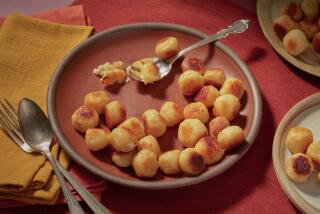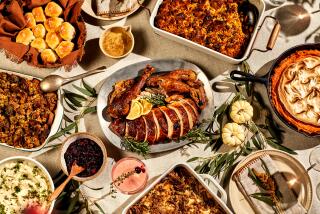Go ahead, bake them
- Share via
BACK in the ‘80s, a cantankerous friend with a taste for prefab food used to insist on bringing his own turkey and trimmings to my Thanksgiving for a taste-off. He was convinced that nothing cooked from scratch would be substantially better than what he could buy at some takeout shop.
Occasionally, in those Butterball days, he might have won the turkey battle. But he always lost the war of the rolls.
Nothing produced by even the best traditional bakery can compare to what comes out of a home oven. Half the pleasure is the smell -- only garlic sauteing can compare to yeast dough baking -- but there are bigger reasons not to settle for the brown-and-serve kind.
Real rolls have texture, not to mention a delicate but discernible crust and a strong taste of yeast and butter.
And they have to be eaten straight out of the oven, while steam is still rising from the soft centers.
Now that artisanal bakeries promoting crust and density have changed the breadscape in America, homemade dinner rolls have a bit of the same retro feel as ripe olives and canned cranberry sauce.
Cookbooks have pretty much abandoned them in recent years. But to me they will always be the essential ingredient in a true Thanksgiving, and knowing they are a do-it-yourself indulgence only adds to their appeal.
They also happen to be surprisingly easy to make, even on the most frenzied cooking day of the year.
Get the dough ready
You can start them the night before, let them rise slowly in the refrigerator overnight, then finish them off as part of the whole carving/gravy-making choreography. The dough needs to warm up to room temperature, and once it’s shaped into rolls it has to sit again, until it’s doubled in bulk (the baker’s way of saying lightened up).
As soon as the turkey comes out of the oven to rest before it’s carved, you can slide the rolls in to bake, and everything gets to the table at once.
Best of all, the dough needs no kneading; you just stir with a wooden spoon. If your yeast is fresh and all the ingredients are at the right temperature, the dough can’t help but rise. But Thanksgiving also provides optimum baking conditions, because the kitchen is so warm and humid.
A sticky dough yields a more tender roll, but it can be a little hard to handle. If it’s too tacky, you can just oil or butter your hands while you tear off and shape each piece.
Flat rounds can be folded over into little pockets to make Parkerhouse rolls, or three balls of dough can be fitted into muffin cups to produce pull-apart cloverleaf rolls, or chunks of dough can be rolled into rounds to make classic rolls.
The whole process does take hours, but then Thanksgiving should be about slowing down and taking time to smell the cooking.
The best recipe I have come across since my mom’s Betty Crocker cookbook is from Kathy Cary, the chef who owns Lily’s in Louisville, Ky. It’s a superb blend of Southern biscuit and airy roll, both buttery and yeasty. She shapes them into little pockets brushed with more butter, but I like to shape them into cloverleafs to maximize the contrast between the crust and the soft center.
As a variation, pumpkin rolls scented with thyme are denser and more strongly flavored. For the lightest dough, these need to rise before they are refrigerated, but that just saves time the next day.
Either of these would have defeated my friend from way back when. The real reason he brought his own turkey was to be sure he went home with leftovers. And with homemade rolls there are none.
*
How to get your dough in good shape
*
Slow-rising Southern dinner rolls
Total time: 30 minutes, plus 2 hours standing and 8 hours chilling
Servings: 12 cloverleaf or 18 dinner rolls
Note: This is adapted from a recipe by Kathy Cary of Lily’s in Louisville, Ky.
1 ( 1/4-ounce) envelope active dry yeast
1/4 cup warm water (110 to 115 degrees)
1 egg
2 tablespoons sugar
1 1/2 teaspoons salt
3/4 cup scalded milk
3/4 cup (1 1/2 sticks) unsalted butter, melted, divided
3 cups flour, plus 1/2 cup more if needed
1. Sprinkle the yeast over the warm water in a small bowl and let stand until bubbly, about 5 minutes. In a 1-quart bowl, beat the egg well, then whisk in the sugar, salt, milk, 1/2 cup of the butter and the yeast and water. Gradually stir in the flour, adding if needed up to 1/2 cup more, just enough to make a soft, very sticky dough. Use a little of the remaining butter to grease a 2-quart bowl. Transfer the dough to the bowl. Cover tightly with plastic wrap and refrigerate at least 6 hours, or overnight.
2. Remove the dough from the refrigerator and let stand at room temperature for 1 1/2 hours.
3. Heat the oven to 400 degrees. Butter either a 12-cup muffin tin or 2 (8-inch) cake pans.
4. Knead and shape the dough into rolls. For cloverleaf, tear off tablespoon-sized balls and place 3 in each muffin cup; for dinner rolls, divide the dough into equal rounds and arrange half an inch apart in pans. If the dough is too sticky, butter your hands well when you handle it. Cover the rolls with a dish towel and let rise in a warm spot until doubled in bulk, 30 minutes.
5. Lightly brush the rolls with the remaining melted butter. Bake until the rolls are just browned on top and bottom, 15 to 18 minutes. Serve warm with plenty of butter.
Each of 18 rolls: 165 calories; 207 mg. sodium; 34 mg. cholesterol; 9 grams fat; 5 grams saturated fat; 19 grams carbohydrates; 4 grams protein; 0.98 gram fiber.
*
Slow-rising pumpkin-thyme dinner rolls
Total time: 30 minutes, plus 2 hours standing and 8 hours chilling
Servings: 12 cloverleaf or 18 dinner rolls
2 ( 1/4-ounce) envelopes active dry yeast
1/4 cup warm water (110 to 115 degrees)
2 eggs, at room temperature
1 cup canned pumpkin puree
1/2 cup (1 stick) unsalted butter, at room temperature
1/2 cup sugar
2 teaspoons coarse salt
1 tablespoon minced fresh thyme (or 1 teaspoon dried)
1/4 teaspoon cayenne pepper
3 cups flour, plus up to 1 cup more
Olive oil, for greasing bowl
2 tablespoons melted butter
1. Sprinkle the yeast over the water in a large mixing bowl and stir to dissolve. Using a wooden spoon, beat in the eggs, pumpkin, soft butter, sugar, salt, thyme and cayenne. Add 3 cups of flour and beat until smooth, gradually adding more flour as needed to make a soft, sticky but still manageable dough. Make sure the dough is well mixed. Oil a larger bowl and scrape the dough into it, turning to oil all sides. Cover with a dish towel and let rise in a warm, draft-free spot until doubled in bulk, about 1 1/2 hours. Punch the dough down, cover tightly with plastic wrap and refrigerate overnight.
2. Grease 2 (8-inch) cake pans with melted butter. Punch the dough down again and shape into round dinner rolls, arranging them in pans with about 1/2 inch between each (if the dough is too sticky to handle easily, lightly butter or oil your hands), or cloverleaf dinner rolls as directed in the Southern rolls recipe. Cover the rolls with a dish towel and let rise in a warm spot until doubled in bulk, 30 minutes.
3. Heat the oven to 375 degrees. Bake the rolls until browned, 20 to 25 minutes. Serve hot or warm.
Each roll: 188 calories; 317 mg. sodium; 40 mg. cholesterol; 7 grams fat; 4 grams saturated fat; 26 grams carbohydrates; 5 grams protein; 1.59 grams fiber.


